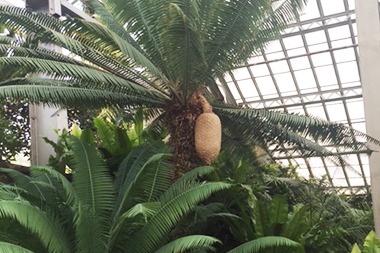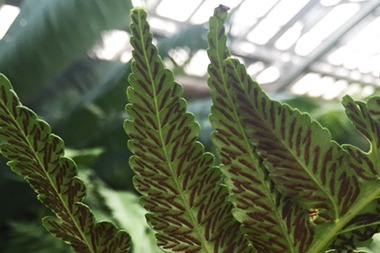Jens Jensen, who designed the Conservatory in 1906, wanted to give visitors a glimpse of what Illinois might have looked like millions of years ago. Lush ferns, rocky outcroppings and an indoor lagoon evoke the swampy landscape of prehistoric Chicago. The Fern House is home to the cycads: ancient cone-bearing plants, ferns and fern allies (plants that thrive in similar conditions and emerged around the same time as ferns, like mosses and liverworts). Many of these plants are considered primitive plants, or members of plant groups that grew during the age of the dinosaurs, about 300 million years ago.
Cycads- Dioon

Cycads are one of the world’s most ancient plants, with few modern-day descendants. These plants can live for up to 500 years. Some of the Cycads in this room are estimated to be over 300 years old.
How can you tell which Cycads are male and which are female? The male Cycad’s cone is long and slender, while the female’s is wide and round. They are fertilized naturally by insects that crawl from one Cycad to the next.
Ferns' spore patterns

Ferns don’t have seeds or flowers, so how do they reproduce? Spores! Fern spores are single cell organisms that grow on the underside of a fern’s fronds and are dispersed by wind. When a spore lands in the right environment, it produces a new fern- similar to the way a mushroom grows.
Fern spores form a wide variety of intricate patterns, differing from one plant to the next. See how many different patterns you can find in the Fern Room! Gently lift the ferns’ fronds and look at the underside to compare.



